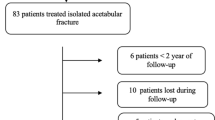Abstract
Background
Open reduction and internal fixation through the Kocher–Langenbeck approach is the treatment of choice for selected acetabular fracture patterns. Patient positioning (lateral vs prone) can affect the outcome and post-operative complications.
Methods
A retrospective cohort of seventy-three adult patients’ with acetabular fractures treated with open reduction and internal fixation through the Kocher–Langenbeck approach in either prone or lateral position. Primary outcome was the quality of radiographic fracture reduction; secondary outcomes included operative time, intra-operative estimated blood loss and pre-operative complications.
Results
The demographics and fracture type were similar between the two groups. There was no difference in the quality of reduction using the Matta radiographic grading. Laterally positioned group demonstrated significant shorter surgical time and lower incidence of iatrogenic sciatic nerve injury. There was no difference in estimated blood loss, heterotopic ossification or infection.
Conclusion
This study showed no difference in the quality of fracture reduction, intraoperative blood loss, post-operative infection and heterotopic ossification between both groups. Hence, patients’ condition, surgeon experience and preference are important factors for deciding patient positioning in the Kocher–Langenbeck approach for acetabulum fracture fixation.


Similar content being viewed by others
Data availability
All data will be available on request.
References
Ahmed M, Abuodeh Y, Alhammoud AJ, Salameh M, Hasan K, Ahmed G (2018) Epidemiology of acetabular fractures in Qatar. Int J Orthop 42:2211–2217. https://doi.org/10.1007/s00264-018-3824-z
Simske NM, Krebs JC, Heimke IM, Scarcella NR, Vallier HA (2019) Nerve injury with acetabulum fractures incidence and factors affecting recovery. J Orthop Trauma 33:628–634. https://doi.org/10.1097/BOT.0000000000001604
Judet R, Judet J, Letournel E (1964) Fractures of the acetabulum classification and surgical approaches for open reduction preliminary report. JBJS 46(8):1615–1675
Perumal R, Valleri DP, Gessesse MT, Jayaramaraju D, Rajasekaran S (2020) Marginal impaction in complex posterior wall acetabular fractures role of allograft and mid-term results. Eur J Orthop Surg Traumatol 30:435–440. https://doi.org/10.1007/s00590-019-02584-3
Giannoudis PV, Grotz MRW, Papakostidis C, Dinopoulos H (2005) Operative treatment of displaced fractures of the acetabulum a meta analysis. J Bone Jt Surg Ser B. https://doi.org/10.1302/0301-620X.87B1.15605
Letournel E (1980) Acetabulum fractures classification and management. Clin Orthop Relat Res 5(5):27–33
Brouwers L, Pull terGunne AF, de Jongh MA, Maal TJJ, Vreeken R, van der Heijden FHWM et al (2020) What is the value of 3D virtual reality in understanding acetabular fractures? Eur J Orthop Surg Traumatol 30:109–116. https://doi.org/10.1007/s00590-019-02537-w
Collinge C, Archdeacon M, Sagi HC (2011) Quality of radiographic reduction and perioperative complications for transverse acetabular fractures treated by the Kocher–Langenbeck approach prone versus lateral position. J Orthop Trauma 25:538–542. https://doi.org/10.1097/BOT.0b013e31820b913d
Negrin LL, Benson CD, Seligson D (2010) Prone or lateral? Use of the Kocher–Langenbeck approach to treat acetabular fractures. J Trauma Infect Crit Care 69:137–141. https://doi.org/10.1097/TA.0b013e3181b28ba6
Matta JM (1996) Fractures of the acetabulum accuracy of reduction and clinical results in patients managed operatively within three weeks after the injury. J Bone Jt Surg Ser A 78:1632–1645. https://doi.org/10.1055/s-0030-1267077
Brooker AF, Bowerman JW, Robinson RA, Riley LH Jr (1973) Ectopic ossification following total hip replacement incidence and a method of classification. JBJS 55:1629–1632
Negrin LL, Seligson D (2017) Results of 167 consecutive cases of acetabular fractures using the Kocher–Langenbeck approach: a case series. J Orthop Surg Res 12:1–8. https://doi.org/10.1186/s13018-017-0563-6
Elnahal WA, Vetharajan N, Mohamed B, Acharya M, Chesser TJS, Ward AJ (2018) Routine postoperative computed tomography scans after pelvic fracture fixation. J Orthop Trauma 32:S66–S71. https://doi.org/10.1097/bot.0000000000001092
Shaath MK, Lim PK, Andrews R, Gausden EB, Mitchell PM, Tissue CM (2020) Clinical results of acetabular fracture fixation using a focal Kocher–Langenbeck approach without a specialty traction table. JOT 34(6):316–320
Funding
This research did not receive any specific grant from funding agencies in the public, commercial or not-for profit sectors.
Author information
Authors and Affiliations
Corresponding author
Ethics declarations
Conflict of interest
All authors confirm that there is no conflict of interest.
Ethical statement
There is a positive statement of the Institutional Review Board for this work.
Consent for publication
All authors have approved the publication.
Additional information
Publisher's Note
Springer Nature remains neutral with regard to jurisdictional claims in published maps and institutional affiliations.
Rights and permissions
About this article
Cite this article
Salameh, M., Hammad, M., Babikir, E. et al. The role of patient positioning on the outcome of acetabular fractures fixation through the Kocher–Langenbeck approach. Eur J Orthop Surg Traumatol 31, 503–509 (2021). https://doi.org/10.1007/s00590-020-02793-1
Received:
Accepted:
Published:
Issue Date:
DOI: https://doi.org/10.1007/s00590-020-02793-1




